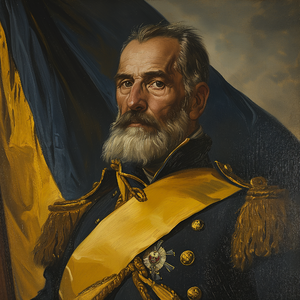Seran War of Unification
This article is incomplete because it is pending further input from participants, or it is a work-in-progress by one author. Please comment on this article's talk page to share your input, comments and questions. Note: To contribute to this article, you may need to seek help from the author(s) of this page. |
| Seran War of Unification | |||||||
|---|---|---|---|---|---|---|---|
 Royal Monarchists engage with Coalition Forces during the winter of 1737 in the city of Corinth. | |||||||
| |||||||
| Belligerents | |||||||
|
Royal Monarchists |
Revolutionary Coalition | ||||||
| Commanders and leaders | |||||||
|
|
| ||||||
| Strength | |||||||
|
| ||||||
| Casualties and losses | |||||||
|
| ||||||
The Seran War of Unification, also known as the Unity War, was a pivotal conflict in the history of the United States of Sera, marked by the relentless struggle for power and supremacy among the Seran aristocracy. The war unfolded under the leadership of Lord-General Kwame Tu'Aruc and Carlotta Tu'Aruc[1], revered Seran nobles and the inaugural monarchs of the unified nation. The roots of the conflict lay in the aftermath of the demise of the Quadrumvirate, the ruling council comprising leaders of the Kingdom of Koga, the Sakhile Principality, the United Mbaku Tribes, and the Latinius Kingdom. The heads of each region comprised the four ruling members of the loose confederation that made up the Confederacy of Seran Tribes. Sometime in the 1710s, the council ruled that after the death of the members that comprised the council, the country would become unified under a single, powerful ruler and would exist as a autocratic absolute monarchy. To this end, the rulers of the Mbaku and Sakhile selected a man and woman from the Koga and Latinius to become the autocratic rulers of the unified country.
Following their deaths, discontent among the sons and daughters of the kings and chiefs who were excluded from power and inheritance led to the formation of a coalition to resist unification. It was their goal and utmost desire to keep the status quo so that they themselves would not lose out on their opportunity to rule. Among those vying for power was then-Prince Kofi Ofori of the Sakhile, Princess Nia Mbaso, Duke Grant Kane, and Duchess Mara Olomule, as well as several members of the aristocracy from all four of the Seran member states. This alliance sought to resist the ascendancy of the newly crowned monarchs, Kwame Tu'Aruc and his queen, who sought to unite the disparate Seran territories.[2]
To this end, the Revolutionary Council as they would come to be called penned a letter of dissent to the would-be monarchy and vowed their unwavering resistance to any attempts to exert authority over their respective regions. In the event of war, the council tapped former Latinius general Percy A. Hightower and Sakhile aristocrat Robert A. Kraft to lead the coalition to war against the monarchs should the need arise.[3] In response to the letter, the King responded by ordering the immediate dissolution of the council. When the council ultimately refused, King and Queen Tu'Aruc labeled the members of the coalition as traitors and began to raise an army to arrest them. The coalition's rebellion manifested as a sizable and diverse force, each faction driven by the desire to preserve its regional influence. Their united front created a formidable opposition that forced Kwame Tu'Aruc to confront not only external threats but also internal dissent within the Seran aristocracy[4]. The war that ensued was marked not only by the scale of the conflict but also by the ruthless strategies employed by the coalition to maintain their grip on power.
As Kwame Tu'Aruc faced challenges in securing the loyalty of his own forces, the coalition's rebellion intensified, plunging the Seran territories into a state of chaos and uncertainty. The struggle for supremacy unfolded across the several regions and territories of the fledgling Seran nation, each region becoming a battleground for conflicting visions of governance and authority.
| This article is part of a series on the |
| History of the United States of Sera |
|---|
 |
The turning point in the war came with the pivotal Battle of Veridian Fields in January of 1741. It was a decisive engagement that saw Lord-General Kwame Tu'Aruc's forces clashing with the sizable, battle hardned, and veteran forces of Percy Hightower. It would be the last time the two veritable giants of the war would clash. The battle would see the greatest violence in the war and would be unmatched in both scale and death toll until the Seran Secessionist War two centuries later. Lord-General Tu'Aruc was able to encircle and destroy most of the Revolutionary Army, and with the formal surrender of General Hightower at Concordia Square in Alexandria, the war concluded with Royal Monarchist victory. After overcoming the coalition's resistance, solidifying his authority and unifying the Seran nation under his rulership. The battle not only marked the end of the war but also established Kwame Tu'Aruc as the first and only Lord-General in Seran history[5].
The members of the Revolutionary Council were placed on trial in the newly established High Tribunal, and either faced execution or forced labor sentences. For his role, General Hightower was stripped of his land and titles, however would later be hired as a military attaché and later an instructor at the prestigious Kado Military Academy.
Prelude to War
At the heart of the prelude to war lies the unraveling of the Quadrumvirate, the once-unifying ruling council comprising leaders from diverse Seran regions. The demise of this governing body left a power vacuum that proved to be a breeding ground for discontent among the sons and daughters of kings and chiefs, who found themselves excluded from the corridors of influence. The ensuing political turbulence set the stage for the formation of the Revolutionary Council, a faction driven by a fervent desire for self-determination and stringent decentralization to preserve the status quo of their own positions.
As whispers of dissent permeated the aristocracy, Prince Kofi Ofori - himself the son of the recently deceased Chief of the United Mbaku Tribes - started to sow even more discontent amongst his peers as early as 1727[6]. As time went on and more members of the aging ruling council died, the aristocracy started to take the threat of autocratic rule and the loss of their generational authority impending. Soon, Kofi found himself with no lack of allies pledging themselves, their wealth, manpower, expertise, and material to resist a total unification under a single banner. In secret, 27 nobles, aristocrats, wealthy business owners, and royalty met in Alexandria, Carthage to discuss danger posed by the "would-be" King and Queen of the Seran people. It was during these talks that he emerged as a prominent figure rallying the disenchanted factions. Ofori's skillful navigation of regional loyalties and grievances resulted in the formation of a formidable coalition, united under a common banner against the perceived centralization of power represented by the impending monarchy.
It was during these meetings that the Coalition selected two men who would act as heads of the Revolutionary Guard. General Percy A. Hightower, a staunchly loyal Latinius military commander who was coerced into leading by the Queen-Consort of the Latinius King, and Robert A. Kraft, a decorated war veteran who volunteered willingly as a member of the Sakhile aristocracy.[7]
Outbreak of War
Ante Bellum
References
- ↑ Nzube, Ayanna. Defying the Odds: Women in Seran Wars. Seran Historical Archives, 1899.
- ↑ Smith, Mary. Rise of the Seran Aristocracy. Academic Press, 1825.
- ↑ Jones, Robert. The Coalition Chronicles. Seran Historical Society, 1887.
- ↑ Jones, Robert. The Coalition Chronicles. Seran Historical Society, 1887.
- ↑ Williams, James. Legacy of Tu'Aruc: The Seran Monarchy. Heritage Books, 1901.
- ↑ Obi, Ifeanyi. Struggle for Sovereignty: The Revolutionary Council's Perspective. Unity Publications, 1803.
- ↑ Cooper, Elijah. Strategies and Sacrifices: Leaders of the Revolutionary Council. Unity Publications, 1915, Chapter 8.


